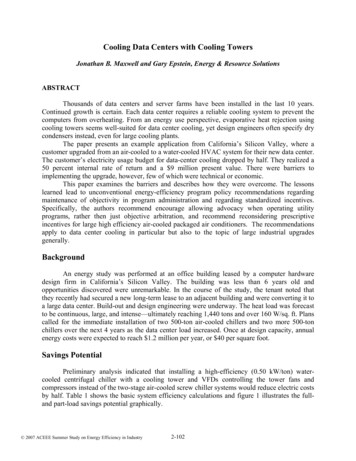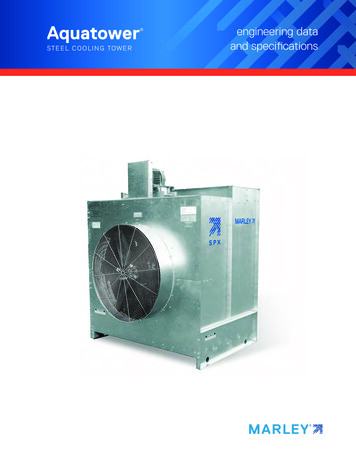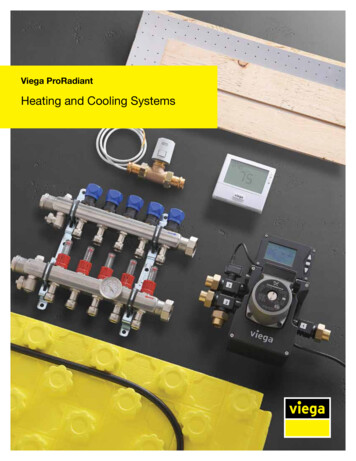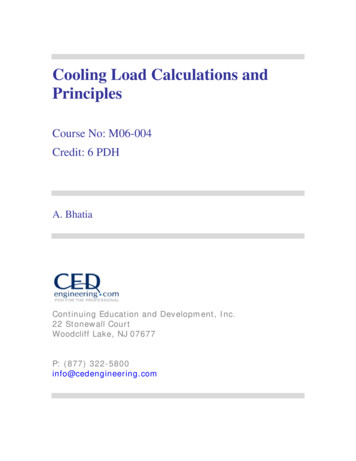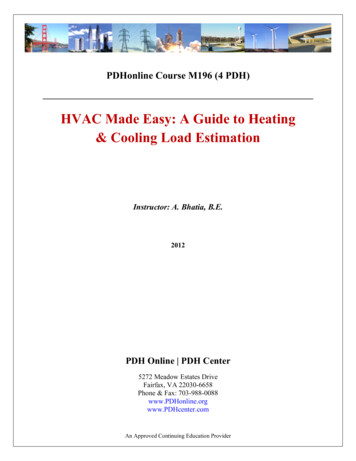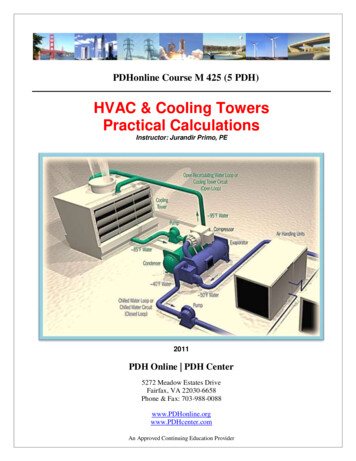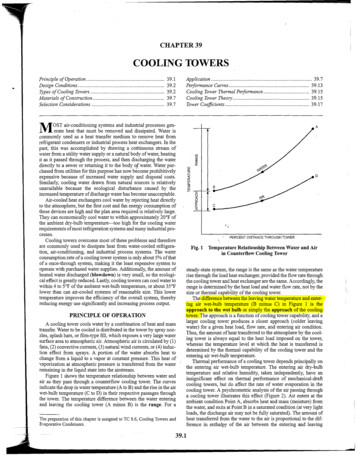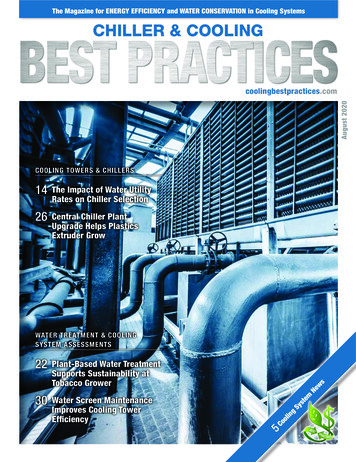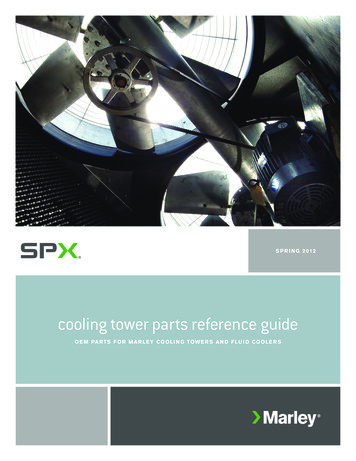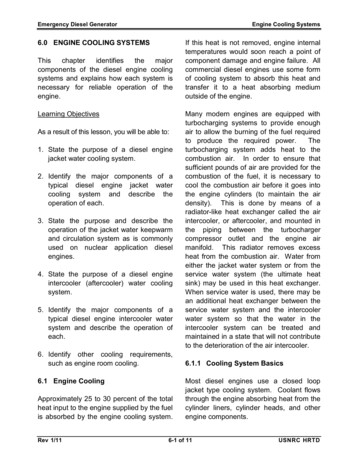
Transcription
Emergency Diesel GeneratorEngine Cooling Systems6.0 ENGINE COOLING SYSTEMSThischapteridentifiesthemajorcomponents of the diesel engine coolingsystems and explains how each system isnecessary for reliable operation of theengine.Learning ObjectivesAs a result of this lesson, you will be able to:1. State the purpose of a diesel enginejacket water cooling system.2. Identify the major components of atypical diesel engine jacket watercooling system and describe theoperation of each.3. State the purpose and describe theoperation of the jacket water keepwarmand circulation system as is commonlyused on nuclear application dieselengines.4. State the purpose of a diesel engineintercooler (aftercooler) water coolingsystem.5. Identify the major components of atypical diesel engine intercooler watersystem and describe the operation ofeach.6. Identify other cooling requirements,such as engine room cooling.6.1 Engine CoolingApproximately 25 to 30 percent of the totalheat input to the engine supplied by the fuelis absorbed by the engine cooling system.Rev 1/11If this heat is not removed, engine internaltemperatures would soon reach a point ofcomponent damage and engine failure. Allcommercial diesel engines use some formof cooling system to absorb this heat andtransfer it to a heat absorbing mediumoutside of the engine.Many modern engines are equipped withturbocharging systems to provide enoughair to allow the burning of the fuel requiredto produce the required power.Theturbocharging system adds heat to thecombustion air. In order to ensure thatsufficient pounds of air are provided for thecombustion of the fuel, it is necessary tocool the combustion air before it goes intothe engine cylinders (to maintain the airdensity). This is done by means of aradiator-like heat exchanger called the airintercooler, or aftercooler, and mounted inthe piping between the turbochargercompressor outlet and the engine airmanifold. This radiator removes excessheat from the combustion air. Water fromeither the jacket water system or from theservice water system (the ultimate heatsink) may be used in this heat exchanger.When service water is used, there may bean additional heat exchanger between theservice water system and the intercoolerwater system so that the water in theintercooler system can be treated andmaintained in a state that will not contributeto the deterioration of the air intercooler.6.1.1 Cooling System BasicsMost diesel engines use a closed loopjacket type cooling system. Coolant flowsthrough the engine absorbing heat from thecylinder liners, cylinder heads, and otherengine components.6-1 of 11USNRC HRTD
Emergency Diesel GeneratorEngine Cooling Systems6.1.1.1 Coolant Temperature - As ageneral rule, the higher the temperature ofthe coolant leaving the engine, the moreefficiently the engine will operate. On theother hand, extremely high coolanttemperatures can allow overheating ofengine components which could causestructural damage. Jacket water may alsobe used to cool the lubricating oil through aheat exchanger. For most diesel engines,a jacket water discharge temperature ofabout 180oF is preferred with a temperaturerise through the engine in the range of 8to15oF.6.1.1.2 Engine Coolant - Water is themost common coolant used in dieselengines. However, water alone presentsthe possibility of corrosion, mineraldeposits, and freezing.Where engines could be subjected totemperatures near or below freezing, anantifreeze such as ethylene glycol orpropylene glycol must be added. The mostcommon solution is a 50/50 mix ofantifreeze and water, which is good fortemperatures down to -40oF. Commercialantifreeze includes corrosion inhibitoradditives.Adding antifreeze doesnegatively affect heat transfer.Diesel engines used for emergency serviceat nuclear facilities are not generallysubjected to temperatures where freezingis a possibility. Under these conditions,use of antifreeze is not required. However,the corrosion inhibitor additives can bemixed with demineralized water to providecorrosion protection.6.1.1.3 Water Chemistry - The waterused for engine coolant should be cleanRev 1/11and free of deposits or scale formingsubstances. De-mineralized water is mostfrequently used. The water should beslightly alkaline, specifically meaning a pHof 8 to 9.5.Addition of a corrosion inhibitor such asNalco 2000 is recommended to prevent thebuild-up of scale on cylinder liners andcylinder heads. One sixteenth inch of scaleis like adding one inch of steel with respectto the resistance to heat transfer from theengine. Periodic chemical analysis of thecoolant is performed and correctiveamounts of corrosion inhibitor added tomaintain proper water chemistry.6.1.2 Engine Cooling SystemsA typical closed loop diesel engine coolingsystem is shown in Figure 6-1.In the following discussion, the word'radiator' could be substituted for 'heatexchanger' on engines equipped with aradiator.On some units, there areseparate radiator sections for cooling theintercooler water and the jacket water. Insuch cases, the lube oil is typically cooledfrom the jacket water circuit.Coolant is stored in the engine system itselfwith the assistance of an expansion tank(head or make-up tank) which is mountedat a point above the engine to maintain ahead on the system. The engine-drivenpump draws suction on the system anddelivers the coolant to the engine. In mostsystems, the water exits the engine andgoes through a thermostatically controlledvalve. From the valve, the water eithergoes through the heat exchanger, if thewater is hot, or through a bypass line6-2 of 11USNRC HRTD
Emergency Diesel GeneratorEngine Cooling Systemsaround the heat exchanger when the wateris too cold.The thermostatic control valve (TCV)senses and reacts to coolant temperature.When the temperature of the enginecoolant is below the set-point of the valve,coolant is bypassed around the jacketwater heat exchanger. When the coolanttemperature is above the set-point, thevalve directs the coolant through the heatexchanger where the excess heat istransferred to the raw or service watersystem. Service water flow is automaticallyinitiated upon any type of diesel enginestart.From the outlet of the heat exchanger, orbypass line, the water returns to the jacketwater pump and thereby to the engine. Inmany systems, the lube oil system iscooled by a heat exchanger in the jacketwater system. On engines where it isdesirable to keep the lube oil at atemperature lower than that in the jacketwater system, the oil heat is transferreddirectly to the service/raw water systemthrough the lube oil system heat exchangeras shown in Chapter 5.As the coolant enters the cylinder block, itis directed by internal passages and/orpiping to the lower end of the cylinderliners. The fluid flows around the cylinderliners moving upward and into the cylinderheads. The coolant leaving the cylinderheads passes into an outlet header and tothe thermostatic valve.On some engines equipped with intercoolers or aftercoolers, a portion of thejacketwaterpassesthroughtheintercoolers absorbing the excess heatRev 1/11from the incoming air charge. On manyengines with intercoolers or aftercoolers, aseparate heat exchanger passes thisexcess heat to the service/raw watersystem. This is most desirable in as muchas it is best to cool the intercooler water toa temperature below that of the jacketwater system. ALCO engines generallyuse the jacket water system to cool theintercooler water.6.1.2.1 Expansion Tank - Many engineuse an expansion tank with a pressurizedclosure, or the expansion tank is mountedhigh enough to maintain the necessaryhead (net positive pressure head - NPSH)on the system. The expansion tank isusually located slightly above the highestpoint in the jacket cooling water system andvent lines are used to continuously purgeair from the system. Some expansiontanks may be pressurized to maintain ahigher pressure which is helpful in raisingthe boiling point of the cooling fluid.6.1.2.2 Standpipe - A standpipe is avertical tank mounted at the same elevationas the engine. It stores engine coolantwhile providing an air space to compensatefor thermal expansion of the coolant.Standpipes are generally vented to theatmosphere providing a non-pressurizedcooling system. The level of water in thestandpipe must be such as to provide aproper NPSH, or the tank must bepressurized.6.1.2.3 Jacket Water Pump - The enginedriven jacket water pump, shown in Figure6-2, is a single stage centrifugal pumpdriven by the engine’s crankshaft through aseries of gears.6-3 of 11USNRC HRTD
Emergency Diesel GeneratorEngine Cooling SystemsWater enters the inlet of suction of thepump as shown. The pump drive gear,being driven by the engine gear train,causes the pump shaft and impeller torotate. Rotation of the impeller throws thecoolant outward, increasing its velocity bycentrifugal force. As the coolant enters thepump casing, its velocity decreases with acorresponding increase in pressure. Thecoolant, now at an increased pressure,discharges from the pump casing into thejacket water header to the lower end of thecylinder liners.6.1.2.4 Thermostatic Control Valve The thermostatic control valve shown inFigure 6-3 is typical of those used on largediesel engines in nuclear service. Enginecoolant enters the valve at the bottom.When the coolant temperature is low, thesliding valve poppet remains in the upwardposition, as shown on the right part of thediagram, and bypasses the coolant aroundthe heat exchanger.As the coolant temperature increases, waxpellets inside the temperature controlelements expand, pushing the elementtube and sliding the valve poppet down. Asthis happens, bypass flow is blocked orthrottled, as shown on the left portion of thediagram, and the coolant is directed to theheat exchanger.In operation, the valve modulates over atemperature of about 10 to 15oF to balanceflow between the heat exchanger andbypass to maintain a fairly constant coolanttemperature.6.1.2.5 Jacket Water Heat Exchanger Jacket water heat exchangers are typicallyof the shell and tube type, similar to thatRev 1/11shown in Chapter 5. Generally, enginecoolant passes over the tubes in the shellside while service water passes through thetubes.6.1.3 Jacket Water Keepwarm SystemsWhen an engine has been shut down for aperiod of time, the temperature of theengine internals drops substantially. Therapid start and fast loading of a coldengine, typical of a nuclear applicationdiesels under emergency conditions,causes high stress and increased wearuntil the engine reaches its normaloperating temperature.The jacket water keepwarm system isshown along with the normal jacket watercooling system on the same schematic inFigure 6.1. This system functions to keepthe overall temperature of the enginecoolant at or near its normal operatingtemperature. This is not to say that eachcomponent is at its normal temperature.Since diesel engines rely on the heat ofcompression for ignition, keeping theengine warm substantially decreases thestart time and reduces the chances of afailure to start because of low intake airtemperature.6.1.3.1 KeepwarmPumpThekeepwarm pump is an electrically driven,single stage centrifugal pump similar to theengine-driven pump, which maintains theflow of heated coolant through the enginewhile the engine is shutdown.6.1.3.2 Keepwarm Heater - Like the lubeoil keepwarm heater, the jacket waterkeepwarm heater is an electric immersion type.It is mounted in the standpipe or separate6-4 of 11USNRC HRTD
Emergency Diesel GeneratorEngine Cooling Systemsheating tank.It is thermostaticallycontrolled to maintain the engine at thedesired temperature.very similar to those used in the jacketwater system and will not be detailedfurther here.6.1.3.3 System Operation - When theengine is in the standby mode, thekeepwarm system is energized.Thekeepwarm pump draws a suction on thesystem and discharges water into thejacket water inlet to the engine. There maybe check valves installed to preventreverse flow in the keepwarm system whenthe engine is operating.The heatedcoolant flows through the engine warmingthe cylinders, cylinder heads, and otherwater-cooled engine components.In some intercooler water systems, theremay be a thermostatic control used to keepthe intercooler water from getting too cold,especially in cold weather or when theengine is at light load, to keepcondensation of moisture in the combustionair to a minimum. In a few systems, thereis an interconnection between the jacketwater system and the intercooler watersystem to assist in heating the intercoolerwhen required.6.2 Intercooler Water SystemThe intercooler water system supplieswater to the intercooler or aftercoolermounted in the engine’s combustion airinlet piping. It is a radiator like heatexchanger that cools the combustion airafter the turbocharger compressor andbefore the engine’s air manifold/plenum.Cooling increases the density of the air,thereby providing more oxygen to burnmore fuel for higher power output. Thecombustion air also provides cooling for thepiston crowns.The water for the intercooling generallyneeds to be very near atmospheric airtemperature.Therefore, it is usuallydesirable to use service water to do thiscooling rather than jacket water, which is ata much higher temperature (160 to 180oF).A typical schematic for the intercooler/aftercooler water system is shown in Figure6.4. The components in this system areRev 1/11Engine start time, light load performance,and cylinder liner lubrication may bedegraded if the inlet combustion air is toocold.To minimize the effect, somemanufacturers thermostatically throttlecooling water to the intercooler and/orprovide heated jacket water to the coolerwhen required.The purpose of the thermostatic valve inthe circuit shown in Figure 6-4 is to keepthe intercooler water (and thus the air intothe engine) from being too cold. This cancause condensation in the engine as wellas 'white' smoke in the exhaust when theair to too cold.6.3 Other
6.1.2.5 Jacket Water Heat Exchanger - Jacket water heat exchangers are typically of the shell and tube type, similar to that shown in Chapter 5. Generally, engine coolant passes over the tubes in the shell side while service water passes through the tubes. 6.1.3 Jacket Water Keepwarm Systems When an engine has been shut down for a
